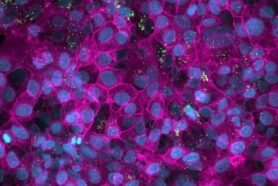News
Can small plastic particles end up in the placenta and how dangerous is that?
Micro- and nanoplastics (MNPs) are everywhere in our environment. Recent research shows that these tiny plastic particles end up in our lungs and blood. Yet little is known about the effects of MNPs on our health. Of special concern are the effects of MNPs on pregnancy and the developing fetus. The fetus is extremely sensitive to environmental pollutants. Harmful substances in the environment can reach the placenta with maternal blood and could even be transported through to reach the baby in the womb, but could this be true also for micro- and nanoplastics? If so how do MNPs affect the development of an unborn child?
“Studying the effects of MNPs on placenta is extremely important as a well-functioning placenta is crucial for the fetal development and maternal health during pregnancy” says Hanna Dusza, who is researching the uptake and effects of MNPs in the placenta cells.
Measuring MNPs effects on the placenta

It is practically and ethically difficult to study the effects of MNPs directly on the mother and the fetus. Fortunately, there are other, more indirect ways of understanding this. For example, placental cells can be grown in vitro (in a petri dish) and used to study the uptake, transport and toxicity of MNPs in a laboratory setting. Such research has been performed by Hanna Dusza and her colleagues. Their findings were published in Environmental Health Perspectives and presented this week at the International Conference of Toxicology in Maastricht.
The research investigated pristine MNPs, purchased directly from a supplier, but also particles that were weathered in the labs to mimic environmental weathering. All particles were taken up by the two important placenta cells. “Interestingly, the pristine but not weathered particles showed subtle effects on the expression of specific genes responsible for hormone production and metabolism”, says Dusza. The placenta is an active endocrine organ producing steroid hormones important for fetal health and development.
Weathering can change chemical composition
“The effects we observed are intriguing and imply that weathering can change the chemical composition of the particles and that there are chemicals that can leach out from pristine particles and possibly influence placental steroidogenesis.” However, if this happens at concentrations that humans are exposed to is still unknown, she adds.
“There are still so many knowledge gaps about the effects of MNPs on our health, especially on such vulnerable stages of human life as fetal development. We need to know much more about the extent of maternal exposure and the toxicity of MNPs before we can estimate potential health risks to the mother and the fetus”, says Dusza.
Addressing knowledge gaps
Juliette Legler, senior author on the paper, adds that these knowledge gaps are being addressed in current projects, such as the MOMENTUM project, a public-private partnership project funded by the Netherlands Organization for Health Research and Development (ZonMw), Health~Holland and various public and private organisations. “In the next few years, we will be much better equipped to answer the question: what is the health risk of MNP exposure in humans?”
This study was supported by the Netherlands Organization for Health Research and Development (ZonMw), under the Microplastics & Health Programme with Project Grant no. 458001003(40-45800-98-106).



